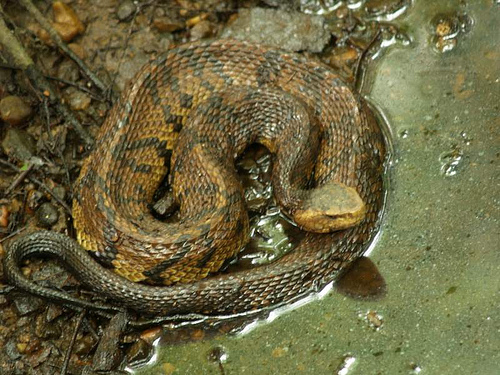Mississippi floods out humans and wildlife
 In late April, two major storm systems across the Mississippi River watershed brought about one of the most catastrophic floods upon the Delta region in generations. Thousands of homes have had to be evacuated and there have been a number of deaths. President Barack Obama has declared bordering counties in Mississippi, Tennessee and Kentucky as federal disaster areas. The flooding along the Mississippi River has also sparked a great migration among the numerous species of wildlife.
In late April, two major storm systems across the Mississippi River watershed brought about one of the most catastrophic floods upon the Delta region in generations. Thousands of homes have had to be evacuated and there have been a number of deaths. President Barack Obama has declared bordering counties in Mississippi, Tennessee and Kentucky as federal disaster areas. The flooding along the Mississippi River has also sparked a great migration among the numerous species of wildlife.
In one of the worst cases of overflow since the Great Depression, the Mississippi River has flooded three million acres across Arkansas, Tennessee and Mississippi. The Mississippi River has the third-largest drainage basin in the world, absorbing 41 percent of the drainage from the 48 contiguous United States, according to the U.S. Army Corps of Engineers. The massive river covers more than 1,245,000 square miles.
According to the National Weather Service, a number of cities are currently experiencing record flood levels. In Natchez, Mississippi, the water now stands at 58.3 feet, shattering the 1937 watermark of 53.04 feet. In Memphis, the Mississippi crested May 9 at 47.8 feet, just under a foot below the city’s record, set in 1937.
A wide range of wildlife is on the move, trying to escape the rising waters. Animals such as deer have been frequently spotted swimming across stretches of water in search of higher ground. Wild turkeys, which nest this time of year, have lost nesting spots and hatchlings to the floodwaters.
Other creatures swept up in the floodwaters include alligators, spiders, rats and even fire ants. Venomous water moccasins have been reportedly appearing everywhere from residential trees to yard porches and sheds. According to the Tennessee Wildlife Resources Agency, it is also mating season for the water moccasins, making the reptiles more aggressive than usual. The Tennessee government has issued a press statement advising residents to avoid the displaced snakes and offering tips on how to treat snake bites.
However, some species may benefit from the floods. Biologists have noted that flood waters, which wash increased amounts of worms and insects into the water, provide extra food to fish such as catfish, common carp, bluegill and crappie. However, an aggressive non-native species, the Asian carp, is also expected to flourish.
Contamination of the water is also a concern, with the Tennessee and Mississippi State Departments of Health warning residents to steer clear of the water for health reasons. The greater Mississippi River is expected to contain a number of contaminants, from trash and farm runoff to untreated raw sewage and chemicals. Testing performed by ABC News found E. coli and coliform at 2,000 times the acceptable limits in samples taken from two locations along the river. Officials are also warning residents of the increased quantities of standing water, which serve as an ideal breeding ground for mosquitoes.
In addition, the annual summer formation of the Gulf of Mexico “dead zone” may well be worse this summer due to the increased amounts of fertilizer washed down the Mississippi and into the Gulf. Each summer, the algal blooms feeding off excess nutrients die off, depleting large areas of oxygen and making it unlivable for many aquatic animals. This will have obvious impacts on a fishing industry still recovering from the Gulf oil spill of 2010. The United States Army Corps of Engineers are currently working to mitigate impacts of flooding in the region.
The flooding also raises the possibility of “river avulsion” commonly known as “delta switching,” the rapid abandonment of an existing river channel in favor of a new river channel. The path of the lower Mississippi River emptying into the Gulf of Mexico changes naturally over the course of every 1,000 years. However, the current flooding could expedite this process, effecting communities and transportation routes across the greater delta region.
Past great floods may foretell what is to come in coming weeks and months for the Mississippi region. The United States Geological Survey reported that, during the Great Midwest Flood of 1993, there were a number of severe impacts on wildlife populations then as is expected now. Mammals displaced from the flood plain suffered increased rates of mortality on adjacent roads and railroad tracks. A number of bird species, including green-backed herons and red-shouldered hawks, lost nesting and foraging grounds due to floods. Substrate disturbance and massive sedimentation buried freshwater mussels beneath one to two feet of sand.
Photo Credit: Hunter Desportes